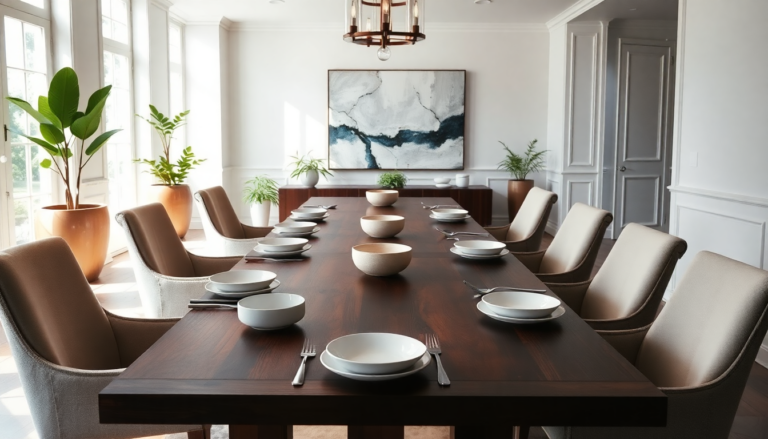Argomenti trattati
The dining room has always sparked interesting conversations in the world of home design. Once a hallmark of status and family togetherness, this space has faced its fair share of challenges due to evolving lifestyles and architectural trends. But guess what? It’s making a comeback! Today, we’re diving into how this traditional space is being revitalized, fueled by a desire for intentional gatherings and a nod to family traditions. Designers are now reimagining dining rooms, turning them from forgotten corners of our homes into vibrant hubs of connection and creativity.
Shifting Trends in Home Design
Historically, dining rooms have held a significant place in American homes. Their roots trace back to Ancient Greece, but it was Thomas Jefferson who truly brought the concept to life in the U.S. with the installation of a dining room at Monticello back in 1772. For many years, these rooms were symbols of status for affluent families. However, as we moved into the late 20th century, the home design landscape began to shift dramatically.
The rise of the great room concept—where kitchens, dining, and living spaces merged into one large area—marked a significant turning point. This change was largely a response to the realization that formal dining rooms were often underused. As Rebecca Lischwe, an associate principal at Richard Beard Architects, points out, homeowners wanted to maximize their space, leading to a growing preference for open and casual living environments.
This great room trend mirrored a cultural shift towards informality and flexibility. Families started to cherish multifunctional spaces that could adapt to various activities, from cooking and dining to relaxing and entertaining. In contrast, the dining room began to feel a bit outdated, often perceived as an unnecessary use of space unless hosting large gatherings.
A Return to Intentional Dining Spaces
Fast forward to the 2020s, and a fascinating change is unfolding. Designers and homeowners alike are rediscovering the value of dedicated dining spaces. This resurgence can be attributed to several factors, including a growing emphasis on mental well-being and a yearning for more meaningful interactions during meals. Doesn’t that sound refreshing?
According to Lischwe, there’s a notable trend emerging: people want to enjoy their meals without the distractions of cleanup or kitchen chaos. This desire has spurred a rise in requests for sculleries and prep kitchens, allowing the main kitchen to remain a serene and organized space during entertaining. How cool is that?
Moreover, dining rooms are increasingly viewed as essential spaces for fostering connection and creating lasting memories. Designer Christopher Boutlier emphasizes that a dedicated dining room encourages people to slow down and truly savor their meals, promoting a more mindful eating experience. This shift ties into a broader trend of valuing quality time spent together, away from screens and other distractions.
Designing for the Future: Blending Functionality with Aesthetics
Modern dining rooms are no longer just formal spaces reserved for special occasions; they are being designed with purpose and flexibility in mind. Lischwe notes that today’s dining rooms often incorporate elements of multifunctionality, serving dual purposes like a welcoming foyer or a reception area. This approach not only enhances the utility of the space but also creates an inviting atmosphere for guests. Who wouldn’t want that?
Adding features such as hidden bars or cozy seating areas can elevate the dining experience, making it more layered and engaging. As designer Cari Berg suggests, a dining room is a perfect canvas for dramatic design choices, allowing for unique materials, artwork, and lighting that might seem excessive in an open-plan setting.
While the great room concept still holds appeal for many families, the resurgence of the dining room signifies a desire for balance between casual living and formal gathering. Design choices are increasingly focused on creating spaces that foster connection, whether through family dinners or gatherings with friends.
Conclusion: Embracing the Dining Room’s Role in Modern Life
The renewed interest in dining rooms reflects broader social trends, including a desire for connection, tradition, and intentional living. Designers are responding to these needs by crafting dining spaces that are not only functional but also serve as central hubs for family life and entertaining.
Looking ahead, it’s evident that the dining room is more than just a relic of the past. It’s poised to reclaim its rightful place in modern homes, providing a sanctuary for meaningful interactions and a canvas for creative design. Whether it’s a space for festive gatherings or intimate family dinners, the dining room is once again becoming a vital part of our home narrative, celebrating togetherness in a world that increasingly values connection.

